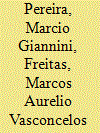|
|
|
Sort Order |
|
|
|
Items / Page
|
|
|
|
|
|
|
| Srl | Item |
| 1 |
ID:
101390


|
|
|
|
|
| Publication |
2011.
|
| Summary/Abstract |
In recent years successive Brazilian governments have actively pursued economic and social policies aimed at reducing poverty and promoting social equality and inclusion. In the field of energy, this has meant introducing and implementing programs aimed at expanding the supply of safe and reliable energy to the poorest sectors of Brazilian society, including those living in remote rural areas. This paper draws attention on the findings of extensive field research to evaluate the impact of rural electrification on energy poverty in the context of government policies aimed at promoting energy equity. The authors re-examine the concept of an energy poverty line, seeking to fine tune its application to Brazilian social and economic realities, and then apply an analytical framework (Lorenz Curve, Gap Poverty, Gap Quadratic, Gini Coefficient and Sen Index) to evaluate the effectiveness of recent efforts in Brazil to expand access to electricity. One of the main conclusions of this study is that is that rural electrification leads to a significant reduction of the energy poverty level and a consequent improvement in energy equity.
|
|
|
|
|
|
|
|
|
|
|
|
|
|
|
|
| 2 |
ID:
133017


|
|
|
|
|
| Summary/Abstract |
The identification of the main sources of anthropic greenhouse gas emissions (GHG) associated with the mitigation and removal of these emissions has become an important instrument in the attenuation of the climatic changes predicted by the IPCC. The largest emission source in Brazil is forest conversion. This land use change has always had a strong relationship with the expansion of agriculture, an activity of great importance in the country, which has the largest commercial cattle herd in the planet. Following the considerable reduction in emissions from deforestation, agriculture has been since 2010 the most important source (MCTI (Ministério da Ciência, Tecnologia e Inovação), 2013. Brasília: Ministério daCiência, Tecnologia e Inovação, Brasil). Seeking to discover the possibilities of altering the emissions profile in the agricultural sector, four scenarios were developed related to how this is dealt with in the beef cattle sector, calculating the potential removal of carbon from the atmosphere through natural regeneration of biomes. The results suggest that picketing and rotation scenario has the greatest potential, with a carbon reduction of 17.7 Gt CO2eq, while the shared raising with grain legumes scenario has the lowest calculated reduction potential of 7.1 Gt CO2eq was calculated. The animal confinement scenario had an intermediary reduction potential of 8.3 Gt CO2eq. The mosaic of methods scenario, in which it is attempted to simulate the parallel adoption of the measures proposed in all other scenarios, had a reduction potential of 13.1 Gt CO2eq. In the scenarios where animal confinement occurs, the treatment of waste with biodigestion allows the generation of biogas and biofertilizers, contributing to an increase in the potential carbon reduction.
|
|
|
|
|
|
|
|
|
|
|
|
|
|
|
|
|
|
|
|
|